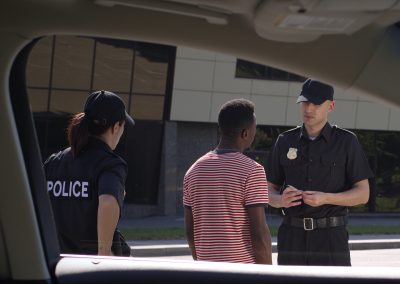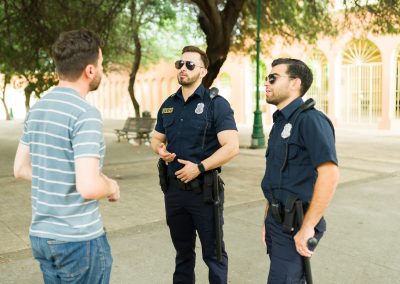When a new recruit graduates from the academy, they’re full of knowledge. They can usually recite policy and procedure verbatim and can demonstrate a handcuffing technique by the numbers. They’re normally in great physical condition and are generally willing to do anything to serve the public. So why not just put them in patrol cars and send ’em out?
You’d never think of putting this new knowledgeable and skilled officer on the street without some type of field training. While the new officer has successfully demonstrated knowledge and skills in the controlled and sterile environment of their academy, they require time and guidance to learn how to apply that knowledge and skill in the everyday world of modern police work.
So why then do so many departments send their new motorcycle officers out on to the street with only the institutional knowledge of their motorcycle academy?
Motors Take Skills, Time
The job of the Field Training Officer (FTO) is to mold and mentor that knowledgeable officer into a wise and focused officer who can survive and thrive on the street. This only makes sense. There’s abstract knowledge and then there’s experience, and an officer requires both. The new officer will learn from observing the FTO interacting with the public, with other officers, and with management. The FTO experience will influence much of the decision-making skills and judgments utilized by the new officer throughout their career. In addition, most departments that hire lateral officers will still provide some type of field training before allowing laterals to work on their own.
The same principal applies to motorcycle skills.
Even those who’ve never ridden motorcycles agree that there’s a high degree of skill and ability needed to control and operate an enforcement motorcycle, monitor the radio to respond to calls, and be on the constant lookout for violations. I’ve known several motorcycle riders who are good, safe pleasure riders, but could not successfully make the transition to operating an enforcement motorcycle.
Most enforcement riding schools are demanding and challenging training courses. They require the student to demonstrate proficiency and discipline in many riding skills. Most schools use a building-block program that begins with the most basic of riding techniques. They then increase the level of difficulty and skills throughout a two- or three-week program. The motorcycle trainee must be able to demonstrate an ability to grasp the concepts and master the skills of operating the enforcement motorcycle throughout each phase of the training course.
Most schools also include an element of real-world riding. The student will be provided with a road map and specific instructions on where to ride. However, throughout all this intense training, the motorcycle trainee is under the watchful eye of the motorcycle instructor. The trainee is given very detailed instruction. Usually they are provided with a demonstration by an instructor before beginning any exercise.
The opportunity for the motorcycle trainee to use personal judgment and demonstrate common sense is restricted nearly as much as a new recruits’ during initial academy training. Often, the motorcycle trainee won’t have an opportunity to react to any hazard that’s not set in place by an instructor during the entire two- or three-week course. This sterile and controlled environment will produce a highly skilled motorcycle operator. However, as we already know with the new officer who just graduated from a police academy, the key to success and safety is being able to apply those skills in the real world.
What we’re talking about is applied decision-making. Training events such as column rides, brake-and-evade exercises, proficiency courses and so on are good to teach motorcycle trainees how things should happen. However, like the handcuffing technique taught at the academy, riding the enforcement motorcycle has twists and turns that can only be learned through experience. These lessons fall to the responsibility of a CMTO, Certified Motorcycle Training Officer, or motorcycle FTO, to mold and mentor that new enforcement rider into a competent and safe motorcycle officer.
If you’re not doing this now, I highly recommend looking into getting such a program started. There is, of course, a cost involved with a motorcycle break-in training program. I would suggest there is greater cost—monetary and human—with not doing break-in training.
The motorcycle FTO is there to pass on the knowledge gained through applying the skills taught in the motorcycle academy to the everyday world of motorcycle patrol. Additionally, the motorcycle FTO will have the ability and responsibility to observe the decision-making process of the trainee and provide guidance and support where needed.
Moreover, the relationship between a motorcycle FTO and a new motorcycle officer will also promote communication. The real world presents challenges that the academy does not, and the motorcycle FTO is there to assist.
To get the most out of it, quantify each trainee’s progress. The motorcycle break-in program should have specific milestones, document accomplishments and provide feedback for the trainee. The experience and guidance of the motorcycle FTO will provide viable and real world answers that may save that new motorcycle officr’s life one day.
Conclusion
If you’re department is already doing this, good for you. If not, it’s not too late to get started. First, get serious and be creative. Some departments may not have the personnel available to provide the training and may have to look to neighboring departments to provide the motorcycle field training for their new riders. These should not be seen as deterrents to providing field break-in training to new motorcycle officers. The rewards of a skilled, capable and safe motorcycle squad will far outlast the immediate cost of providing the training.
Next up: We’ll look at the selection process for motorcycle FTOs and outline various motorcycle break-in programs.










0 Comments